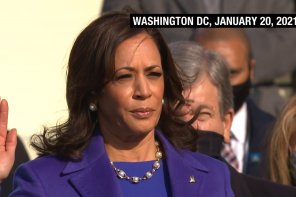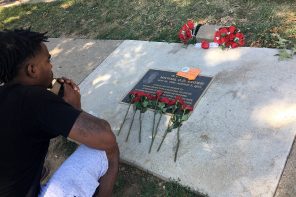Last night, Seattle Seahawks cornerback Richard Sherman declined to take questions during a press conference, opting instead to give a plainspoken but powerful speech on the police killings of black men and the damage it does to black communities, especially the youth with whom he volunteers. He said:
When you tell a kid, “When you’re dealing with police, just put your hands up and comply with everything,” and there’s still a chance of them getting shot and no repercussions for anyone, that’s an unfortunate time to be living.
He went on to reference the death of Terence Crutcher, and 49ers quarterback Colin Kaepernick’s ongoing protest, covered earlier this month here in RD by Ben Zeller.
As Zeller so acutely points out, the visceral reaction to Kaepernick’s refusal to salute the flag—accusations that the quarterback is un-American, selfish, dangerous, unappreciative—reminds us that the flag is a sacred object. It functions like any other religious object, even if we associate it with “secular” rituals and practices.
These bodily refusals invoke dissonant memories of incessant black suffering and death, memories that cannot be converted into a moment of celebration and collective self-worship.
Drawing on the early 20th century French sociologist Emile Durkheim, Zeller argues that the flag is a powerful rallying point for collective ideals. It is a totem that occasions—and demands—the nation’s collective worship. As Zeller writes: “To threaten the totem, particularly in large groups (such as on national television) is to call into question the foundations of society.”
Yet it’s not clear that Kaepernick intends to shake the foundations of America, to question the sacredness of America’s ideals. In fact, he said,
This country stands for liberty, justice, for everyone. And its not happening for all right now…I have family, I have friends that have fought for this country. They fight for liberty and justice, for everyone…
Here Kaepernick invokes a long legacy of criticism—often referred to as the American jeremiad—that directs attention to the gap between ideals and reality. While critique is directed toward the failure to live up to certain lofty, democratic notions, the sacred quality of these notions (liberty, justice for all) is not questioned.
In addition, the close link between America and freedom—not to mention America’s capacity to strive and fight for “everyone”—is left unchallenged.
The problem, Kaepernick suggests, is that the country is not “holding its end of the bargain,” not living up to its professed ideals—especially when it comes to black people and military veterans. One can imagine another kind of interpretation that would question the intrinsic purity of these ideals, that would show how “our” freedom and justice—rather than being fought for everyone—is always intertwined with coercion, suffering, dispossession, and danger for some community.
While Kaepernick doesn’t take his vocal critique that far, his detractors are aware that the bodily performance of dissent in a public space might have effects that cannot be contained.
His critics implicitly recognize that images of black players opting out of the national anthem or raising a black fist—especially on the fifteenth anniversary of September 11th, and especially on the hallowed day of Sunday football—necessarily interrupt rituals designed to generate pleasant feelings of cohesion and pride. These images “introduce” tension and conflict into national rituals that are supposed to transcend race and other sources of divisiveness.
These bodily refusals invoke dissonant memories of incessant black suffering and death, memories that cannot be converted into a moment of celebration and collective self-worship—as remembrance of the tragedy of 9/11 so often becomes.
Black bodies have routinely been imagined as sources of disorder and danger, especially when they don’t stay in their proper place.
In other words, these moments of black dissent threaten to “contaminate” the sacred space, and time, of Sunday football and the nation-state.
Think for instance of Wayne Newton’s recent response to the football player protest. On Fox and Friends, he stated:
I think every American has the right to do or say whatever freedom offers us. However, during a national anthem is not a time or a place to show that kind of thing. I have no tolerance at all for it.
There is so much packed into this statement, but most noteworthy is the way that Newton’s invocation for freedom also marks a limit for tolerance, a point at which freedom stops.
In addition, Newton suggests that protest, that “kind of thing,” does not belong in the place, or time, of the national anthem. The performance of the anthem, the public celebration of America, should be protected from displays of resistance and dangerous memories of black suffering.
This is why actor Rob Lowe tweeted that players who want to protest on 9/11 should “remain in the locker room until kickoff”:
Dear @NFL Any player wants to boycott the anthem on 9/11 should be asked to remain in the locker room until kick off. It's not their moment.
— Rob Lowe (@RobLowe) September 11, 2016
Interesting here is how the containment of black protest mirrors the containment of religion within liberalism. Protest, like religion, is fine as long as it is confined to its proper, and private, place.
While Sunday football and the celebration of the nation are treated as sacred rituals, we should remember the ambivalence of the term “sacred.” On the one hand the sacred invokes order, cohesion and protection; on the other, it can summon impurity, disorder and danger. Durkheim suggests that taboos and prohibitions are established to prevent the latter sacred from contaminating the former.
Because the darker form of the sacred undermines our sense of order and security, it often engenders “fear that usually has a component of horror.” (Here we might think of supermodel Kate Upton’s description of national anthem protest, on the anniversary of 9/11, as “horrific.”)
While there is not enough space here to trace the connections between blackness and the dark sacred, one should just note how black bodies have routinely been imagined as sources of disorder and danger, especially when they don’t stay in their proper place.





